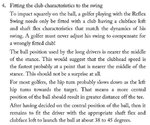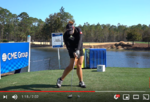At the point of impact, if a club is still in a convex shape, it is going to be more inefficient as it hasn't released the stored energy in to the ball
At the same time, a club that has moved to a concave shape has passed the point of maximum energy transfer so will also be inefficient as well
Even taking your fishing rod analogy, the maximum point of energy transfer is when the rod reaches a straight point, not when it is a convex shape, as a convex shape is not producing any forward momentum
At the same time, a club that has moved to a concave shape has passed the point of maximum energy transfer so will also be inefficient as well
Even taking your fishing rod analogy, the maximum point of energy transfer is when the rod reaches a straight point, not when it is a convex shape, as a convex shape is not producing any forward momentum





 :bicker::deadhorse::facepalm: Sums up this thread, publish a paper disproving the laws of physics and releasing of kinetic energy and after peer review if you are right, come back and we can discuss this revolutionary new development in the golf swing.
:bicker::deadhorse::facepalm: Sums up this thread, publish a paper disproving the laws of physics and releasing of kinetic energy and after peer review if you are right, come back and we can discuss this revolutionary new development in the golf swing.












